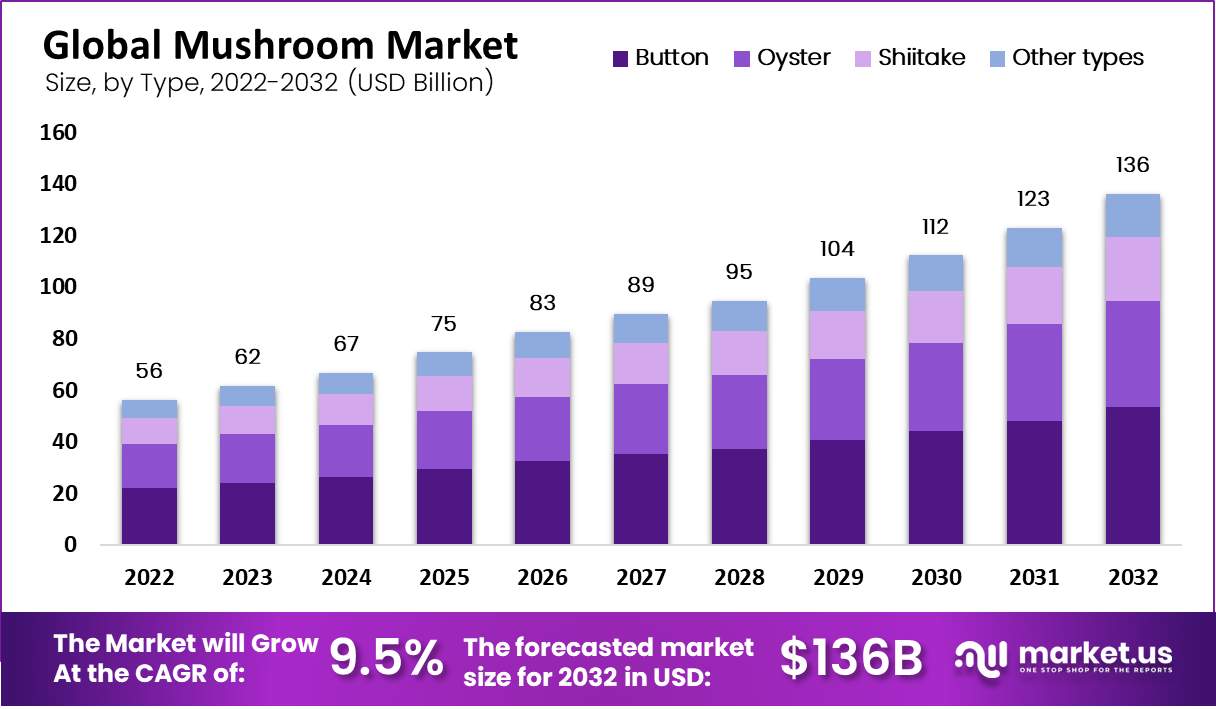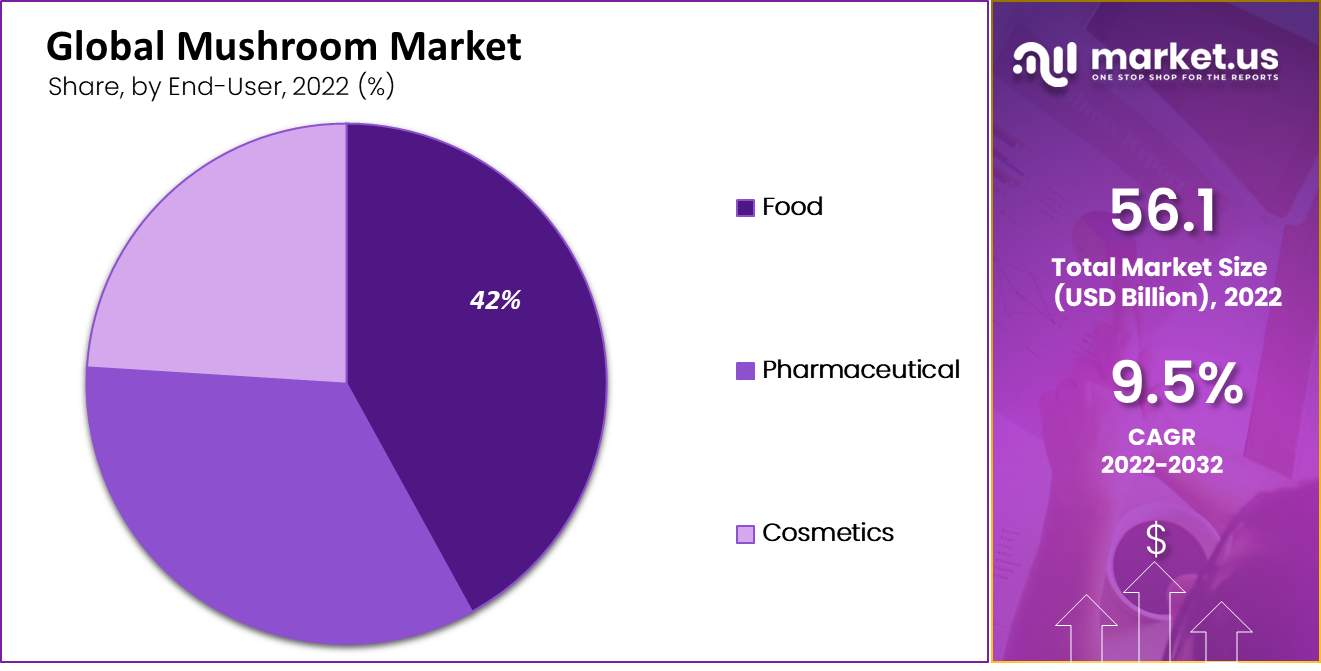Table of Contents
Introduction
According to Mushroom Statistics, Mushrooms separate from both plants and animals, are cultivated through precise methods like substrate-based growth and controlled environmental conditions. Varieties such as button, shiitake, and oyster mushrooms boast distinctive flavors.
They are renowned for their nutritional value, being packed with vitamins and minerals while remaining low in calories and fat. The global mushroom market is on the rise due to increasing consumer awareness and the perceived health benefits of mushrooms.
Challenges include the susceptibility to diseases, but there are prospects in the organic and specialty mushroom sectors and sustainable cultivation practices. Consumers are gravitating toward organic and exotic mushroom choices. To sum it up, mushrooms are a varied and nourishing food source with a promising future in the market.
Editor’s Choice
- In 2023, the global mushroom market was valued at 62 billion USD.
- The food industry claims the largest share, commanding 42% of the market, highlighting the significant presence of mushrooms in culinary applications worldwide.
- In a typical serving, which is about to provide 15 calories, mushrooms are remarkably low in fat, containing only 0.2 grams.
- Global mushroom production started at 0.17 MT in 1960 and reached 34.8 MT by 2013, and it is believed to have exceeded 40 MT currently.
- In the global landscape of mushroom and truffle production, Mainland China emerges as the undisputed leader, contributing a staggering 41,117.74 thousand metric tons to this thriving industry.
- According to Volza’s Global Export data, worldwide shipments of dried mushrooms reached 147.8K units, with contributions from 2,594 exporters serving 4,212 buyers.
- In the global market for fresh or chilled mushrooms, Poland emerges as a prominent player with a substantial export value of USD 492.56 million.
- In May 2022, the cost per ton of mushrooms stood at $4,471 (CIF, US), marking a 4.4% decrease compared to the previous month.
Global Mushroom Market Overview
Global Mushroom Market Size
- The global mushroom market has exhibited a steady upward trajectory in recent years at a CAGR of 9.5%, as evidenced by the data representing its growth in terms of USD billion.
- In 2022, the market was valued at 56 billion USD, which increased to 62 billion USD in 2023.
- Looking ahead, the market is expected to maintain this upward momentum, with estimations pointing towards a value of 83 billion USD in 2026, 89 billion USD in 2027, and 95 billion USD in 2028.
- The growth is projected to continue, with the market set to reach 123 billion USD in 2031 and an impressive 136 billion USD in 2032.

Global Mushroom Market Size – By Type
- The global mushroom market, segmented by various types including Button, Oyster, Shiitake, and other varieties, has shown consistent growth in terms of revenue in recent years.
- In 2022, the total market revenue was recorded at 56 billion USD, with Button mushrooms contributing 22 billion USD, Oyster mushrooms 17 billion USD, Shiitake mushrooms 10 billion USD, and other types accounting for 7 billion USD.
- This growth trend is expected to persist, with the market forecasted to achieve a total revenue of 136 billion USD in 2032, reflecting the resilient and promising nature of the global mushroom industry across its various segments.

Global Mushroom Market Share – by End-User
- The global mushroom market exhibits a diverse distribution of market share across different end-use industries.
- In this breakdown, the food industry claims the largest share, commanding 42% of the market, highlighting the significant presence of mushrooms in culinary applications worldwide.
- Following closely is the pharmaceutical sector, which holds a substantial 34% share, showcasing the growing importance of mushrooms in the development of pharmaceutical products and medicines.
- Additionally, the cosmetics industry also plays a notable role, accounting for 24% of the market share, indicating the utilization of mushrooms in skincare and beauty products.

Nutritional Facts About Mushrooms
- Mushrooms, often enjoyed as a culinary delight, offer a nutrition profile that combines both flavor and health benefits.
- In a typical serving, which is about to provide 15 calories, mushrooms are remarkably low in fat, containing only 0.2 grams.
- Their sodium content is relatively minimal, measuring at 3.5 milligrams, making them a suitable choice for those watching their salt intake.
- On the carbohydrate front, mushrooms contribute 2.3 grams, with a notable portion of that comprising dietary fiber, standing at 0.7 grams.
Global Mushroom Production Statistics
- According to FAOSTAT data, mushroom production grew from 0.5 million tonnes (MT) in 1961 to 10.24 MT in 2017.
- Global mushroom production started at 0.17 MT in 1960 and reached 34.8 MT by 2013, and it is believed to have exceeded 40 MT currently.
Mushroom Production According to Continent
- The global distribution of mushroom production reveals a compelling breakdown across continents.
- Asia takes the forefront in this dynamic industry, commanding a substantial 82.8% share, underscoring its dominance in the cultivation of mushrooms.
- In contrast, Europe contributes 12% of the global production, positioning itself as a significant player in the market.
- Oceania and Africa make more modest contributions, accounting for 0.4% and 0.3% of the total production, respectively.
- The Americas, encompassing North, Central, and South America, collectively make up 4.5% of the global mushroom production landscape.

Leading Mushroom and Truffle-Producing Nations
- In the global landscape of mushroom and truffle production, Mainland China emerges as the undisputed leader, contributing a staggering 41,117.74 thousand metric tons to this thriving industry.
- Following at a considerable distance, Japan stands as a notable player with a production output of 469.05 thousand metric tons, showcasing its significance in the market.
- Poland, with its robust agricultural sector, secures the third position with a production volume of 387.8 thousand metric tons, highlighting its role as a major contributor.
- The United States and the Netherlands follow closely, producing 343.82 and 260 thousand metric tons, respectively.
- India and Spain further bolster the global production landscape with 243 and 163.8 thousand metric tons, respectively.

Mushroom Export Statistics
- According to Volza’s Global Export data, worldwide shipments of dried mushrooms reached 147.8K units, with contributions from 2,594 exporters serving 4,212 buyers.
- The primary destinations for global dried mushroom exports are the Netherlands, the United States, and Germany.
- Germany leads as the largest exporter with 13,657 shipments, followed closely by China with 13,187, and the Netherlands securing the third position with 12,061 shipments.
Key Mushroom Exporting Nations
- In the global market for fresh or chilled mushrooms, Poland emerges as a prominent player with a substantial export value of USD 492.56 million.
- Following closely behind is Canada, contributing significantly to the industry with exports valued at USD 323.39 million.
- The Netherlands and Ireland also make notable contributions, with export values of USD 161.82 million and USD 111.4 million, respectively.
- While China, Mexico, and Belgium exhibit relatively lower export values at USD 35.26 million, USD 29.2 million, and USD 28.8 million, they remain active participants in this market.
- In contrast, the United States and the United Kingdom demonstrate comparatively modest export values of USD 23.03 million and USD 21.66 million, while Lithuania rounds out the list with exports valued at USD 20.31 million.

Mushroom Import Statistics
- In May 2022, Canada emerged as the primary supplier of mushrooms and truffles to the United States, contributing 6,000 tons, which accounted for a substantial 76% of total imports.
- Notably, Canada’s mushroom and truffle imports to the United States were five times greater than those from Mexico, the second-largest supplier, which provided 1,300 tons.
- China secured the third position, with 350 tons, representing a 4.4% share.
- Throughout the period from January 2022 to May 2022, Canada demonstrated steady, albeit modest, monthly growth in volume.
- Conversely, Mexico and China experienced monthly declines of -3.3% and -22.4%, respectively.
Mushroom Cost Statistics
- In May 2022, the cost per ton of mushrooms stood at $4,471 (CIF, US), marking a 4.4% decrease compared to the previous month.
- Throughout this period, the import prices remained relatively stable, with the most significant increase occurring in March 2022, when the average import price rose by 5.7% month-on-month, reaching a peak of $4,747 per ton.
- However, from April 2022 to May 2022, import prices showed limited growth. Notably, prices varied significantly depending on the country of origin, with Canada having the highest price at $4,769 per ton, while China offered one of the lowest prices at $1,305 per ton.
Customer Preferences in Buying of Mushrooms
According to Gender
- Customer preferences for purchasing mushrooms are influenced by gender, with a noticeable disparity in percentages.
- Among mushroom buyers, 60% are male, while the remaining 40% are female.

According to Age Group
- Customer preferences for purchasing mushrooms exhibit variations across different age groups.
- The data reveals that the 18-24 age group constitutes the largest segment of mushroom buyers, comprising 41.3% of the total.
- Following closely behind, the 25-34 age group accounts for 33.8% of mushroom consumers. In contrast, the 35-44, 45-54, and 55 and above age groups represent smaller percentages of 13.1%, 6.3%, and 5.6%, respectively.

According to Mushroom Varieties
- Customer preferences in mushroom purchases vary significantly depending on the type of mushroom.
- The data indicates that the majority of consumers, constituting 68.8%, prefer button mushrooms.
- Oyster mushrooms also garner a substantial portion of the market, with 23.1% of buyers favoring this variety.
- The remaining 8.1% of customers have a preference for other mushroom types.

Mushroom Production and Processing Challenges
- A substantial majority, comprising 82%, had not been informed about the utilization of gamma irradiation for sterilizing mushroom compost.
- The remaining 18% were knowledgeable about its application in compost sterilization before the introduction of mushroom spores.
- The survey findings also revealed that 34% of the respondents believed that the sterilization process required more attention within the mushroom cultivation industry.
- Meanwhile, 50% expressed a desire for improvements in the inoculation process to ensure the exclusion of contaminants.
- Approximately 8% emphasized the need for enhanced focus on packaging, while the opinions of the remaining respondents were undecided.
Discuss your needs with our analyst
Please share your requirements with more details so our analyst can check if they can solve your problem(s)



